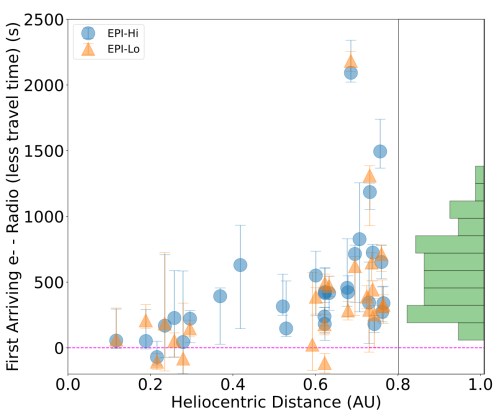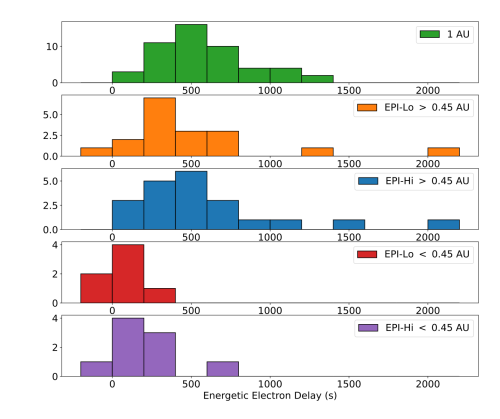Delay of Near-Relativistic Electrons
| Nugget | |
|---|---|
| Number: | 496 |
| 1st Author: | Grant MITCHELL |
| 2nd Author: | |
| Published: | May 19, 2025 |
| Next Nugget: | |
| Previous Nugget: | A Multi-Site Telescope for Multi-Height for Synoptic Observations, Multi-Height Multi-site Synoptic Observations |
Introduction
Solar radio emission at long wavelengths (20-1000 MHz) has a very common pattern: type III bursts feature striking drifts from high to low frequencies. This is easily interpretable as radiation at the local plasma frequency as some sort of agent flies away from the Sun into regions of lower density. This agent was identified as a stream of particles by Ruby Payne-Scott, specifically suprathermal electrons (~2-25 keV); as they stream out from the solar corona into interplanetary space to they generate a "bump on tail" instability which produces Langmuir waves. These couple to electromagnetic waves seen as type III emission.
The characteristic fast drift from high frequencies several orders of magnitude down to the local plasma frequency of the observer is due to the fact that the emission is proportional to the square root of the local electron density at the location in which the Langmuir waves are excited. This density is high in the corona and then falls off as the electron beam streams out into interplanetary space. Near-relativistic (NR) and relativistic electrons (hundreds of keV to MeV) are also accelerated by solar eruptive events and have been observed in-situ for decades. Studies have shown a 99% correlation between the measurement of in-situ NR electrons and the presence of type III emission.
Characteristic delay
Studies have found that there appear to be delays in the inferred injection time of the NR electrons compared with the start of the type III emission (on average ~10 minutes according to Ref. [1]) This discovery has led to a debate regarding the source of these delays as either 1) due to an actual delayed injection (or release) of the near-relativistic electrons or 2) a delay produced in transit through the interplanetary medium. Several studies suggested that the delay is due to the NR electrons being accelerated by an ICME-driven shock, particularly due to the time it takes a shock to travel through to corona. However, others have found evidence that the delay is likely due to transport effects, particularly as near-relativistic electrons are known to have shorter mean free paths than their suprathermal counterparts. However, all previous studies of these delays were performed using observations at 1 AU and thus could not conclusively decouple the roles of acceleration and transport in producing these characteristics.
Observations by Parker Solar Probe/ISIS
The study highlighted in this Nugget (Ref. [2]) used the unique orbital characteristics ("touching the Sun") of the Parker Solar Probe to study the delay between the start of type III radio emission and the injection of the NR electrons (both propagated to the solar surface) from 0.12-0.77 AU. The primary idea was that if the delay was indeed purely due to a delayed injection of the NR electrons as had been posited, one would expect to see the same distribution of delays regardless of observing distance of the spacecraft. On the other hand, if transport plays a role, one would expect to observe a relationship between the distance of the spacecraft and the delay of the NR electrons. Figure 1 shows the relationship between the calculated delay time of the NR electrons as a function of observing distance of the Parker Solar Probe spacecraft along with sample 1 AU data (Ref. [3]) shown as the histogram on the far right of the figure. Long delays (>300 s) are not observed when the spacecraft is close to the Sun, implying that transport must play a role in the observed delays at 1 AU.

Figure 2 shows the same data binned into events observed when Parker Solar Probe was within 0.45 AU of the Sun and past 0.45 AU to show that long delays of the type observed at 1 AU are only observed when the spacecraft is far from the Sun.

Conclusions
This work utilized the unique orbit and proximity of Parker Solar Probe to the Sun to demonstrate that the long-studied delay of NR electrons with respect to type III radio emission cannot be explained solely by a delay in the injection or release of the NR electrons and that transport of these electrons through the interplanetary medium must contribute to these delays.
References
[3] "Near-Relativistic Solar Electrons and Type III Radio Bursts"